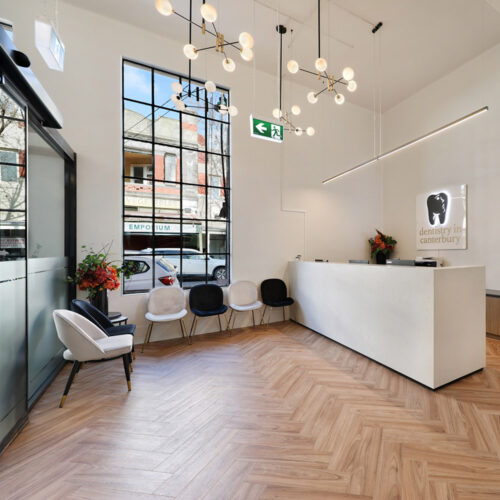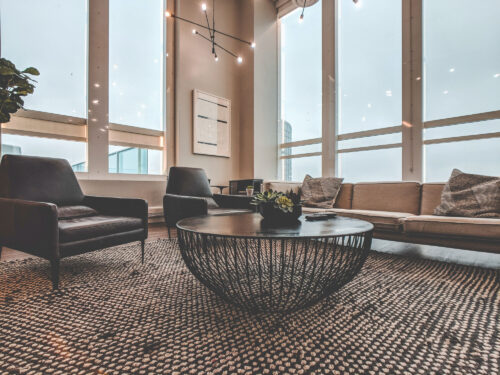Nowadays, there’s no shortage of options for healthcare. To reach today’s savvy, selective healthcare consumers, a well-designed and thoughtful healthcare and medical fitout is key to ensuring an exceptional patient experience.
A positive patient experience is a driving force that will get patients coming back and boost your financial outcomes. Your healthcare and medical fitout, from interior design and furniture to external signage and access can impact patient mood, satisfaction and the overall patient experience.
As healthcare and medical fitout experts, we thought we’d share what aspects of your medical fitout you can change to improve the patient experience.
What is patient experience?

Patient experience is a measure of how satisfied or dissatisfied the patient found their interactions with the medical practice or healthcare provider. The experience is influenced by all the touchpoints in the patient’s journey including:
- online interactions with your website and social media
- initial contact whether this be through a phone call, email, app, online booking or in-person visit
- physical experience at the clinic from parking, entry, seating, amenities available
- speaking to reception and wait time for appointments
- treatment, consultation or service
- post-visit care such as an email with post-care instructions or reminder texts for the next visit

Why patient experience matters
When it comes to building a profitable and successful medical practice, there’s probably nothing more important than your patients. A greater patient experience can lead to better patient satisfaction. It can help attract new patients and keep current patients coming back.
But these days, patients are expecting much more from their health care – just treating their symptoms or health concerns isn’t going to cut it. Patients are after high quality and efficient service and there’s a high chance they’ll go elsewhere if an interaction is anything but excellent. A global study by Salesforce of nearly 6000 people found 82% would switch healthcare providers as a result of a bad experience.
By ensuring a positive patient experience, you can build brand reputation, create loyal and happy advocates who can provide positive reviews and word of mouth, attracting new business. It’s also less costly to retain patients than get new patients.
So how can you improve patient experience at your healthcare or medical practice? One crucial touchpoint is your healthcare and medical fitout. This encompasses the interior and exterior design of your practice, including how it looks and feels to the patient.
How a healthcare or medical fitout can boost patient satisfaction and retention

A lot is going on when you pay a visit to a healthcare professional. The anxiety over symptoms, insecurities over possible diagnosis and lack of understanding of medical procedures are just a few things that make the trip even more unpleasant and stressful.
Conventional healthcare and medical fitouts don’t help. With cold, sterile white palettes, it’s little wonder why hospitals, dental practices and other medical and healthcare clinics are associated with discomfort, fear and unease.
The connection between interior design and its impact on alleviating anxiety isn’t new. The fitout and interior design – from the colour palette, finishings, lighting, to surface textures and layout of the space – can trigger positive or negative emotions in people. Make the most of your medical fitout with design, furniture and fixtures that evoke calmness, comfort and positivity in patients.
By creating a welcoming and relaxing environment for patients, you can lower stress and anxiety. You’ll also associate your clinic or practice with a bright, serene and home-like environment – the kind of feelings that’ll make patients comfortable enough to come back for another visit.
And when patients feel good about the visit, they develop trust, a sense of loyalty and are also more likely to recommend your practice (and less likely to turn to your competitor). This in turn can lead to positive reviews, recommendations and increased profitability.
Knowing that architecture and interior design can increase patient satisfaction, reduce costs and improve patient outcomes, what features of your medical fitout impacts patient experience the most?
Designing a healthcare and medical fitout focused on positive patient interactions

Appeal from the outside
A good first impression starts before the patient walks into your practice.
- How does the exterior of your building look?
- Is your practice clearly identifiable?
- How easy is it to locate and get to?
- Is there car parking and mobility access?
- How is the outdoor landscaping/gardening?
For new patients who already may be stressed about their visit, any difficulty locating a practice or unwelcoming physical environments (such as cracking paintwork, overgrown bushes and plants) will only serve to heighten their stress and worries.
Help future patients find your practice with clear branding and easy to understand signage and wayfinding. Agero can provide signage and branding options aligned with your medical fitout design for a cohesive and consistent feel and look from out to in.
Feel more at home in the reception and waiting area
As one of the first, physical interaction points, the reception area and receptionist can set the tone of the visit and leave patients with either a poor or inviting first impression.
To ensure a more comfortable and relaxing visit, it is becoming more common for the interior design and medical fitout in the reception and waiting area to replicate a living room at home. Every last detail from lighting, artwork and plant choice is curated to reflect the practice’s brand and personality.
Rearrangeable and modular furniture is also proving popular, allowing you to adjust layouts for different patients such as for families to sit together or for mobility impaired patients. It not only opens up space but patients can also change this to suit their comfort.
With rapid technological innovation, we’re also seeing a jump towards smarter facilities such as check-in kiosks to make check-in a breeze while minimising paperwork and wait times.

Waiting room perks
Have you ever tried sitting in your waiting room for half an hour?
The waiting area is possibly where patients and their families spend the most time and while a bit of a wait is understandable, excessive wait times can increase stress, anxiety and frustration.
Take care and service in your waiting room to the next level by
- Adding refreshments like coffee, tea and water
- Integrating technology such as Wi-Fi, USB ports, charging stations and other entertainment to keep both young and older patients occupied
- Incorporating natural light, plants, water and garden views – studies show they reduce stress, aid healing and create a calm, relaxing environment
- Update your furniture and switch from rows and rows of chairs to tasteful décor and cushy armchairs
- Having inclusive space, seating, access and amenities for those that might be mobility impaired or injured
- Reducing noise with absorbent ceiling tiles and acoustic panels for privacy and soothing surrounds
- Will children be frequent visitors? Set up creative play areas and activities
- For larger facilities, consider having a small café for food or a mini fridge for smaller practices
With the right medical fitout, you can optimise your reception and waiting room for functionality and flow, while making the entire space contribute to wellbeing and a positive patient experience.

Going beyond vanilla
Why are so many healthcare interiors all white? White has long been associated with healthcare and clinical settings. Naturally, white provides a clean and hygienic feeling, but it can also give off a cold and unfriendly air – making healthcare practices much more intimidating than they really are.
Adding a touch of colour to the walls, furniture, fixtures, or art can create a positive distraction and reduce stress for patients. You can even incorporate colours that reflect your brand.
There have been studies that explore the effects of colour on stress and anxiety in healthcare environments. Given their relation to nature, green and blue is often associated with positive feelings, calm and serenity. Red, on the other hand, is known to elicit strong emotional reactions. Brighter colours are better for the elderly whose eyesight can’t see pastel colours or differentiate subtle colour changes as well.
Through careful choice of colour, furniture and flooring, healthcare facilities can provide a more comfortable environment that enhances the patient experience and positively impact health and recovery.
Does your healthcare and medical fitout need a check-up? We can help!

Designing and building a medical fitout is a unique challenge with strict building requirements and planning codes. This is on top of the various functional complexities and specialised medical needs that differ between each healthcare facility.
A medical fitout shouldn’t be about spending more but spending the amount creatively. At Agero, we understand the impact an effective fitout design has on the smooth running of your practice and patient experience. We like to put ourselves in the patient’s shoes, taking into consideration comfort and patient flow. We’ll also take care of building compliance, as well as ensuring flexibility with your fitout to incorporate future changes.
If you have a new healthcare facility or need to extend, refurbish or update your current practice, get in touch with Agero today to see how your medical fitout can add to your mission of providing the best patient care.


